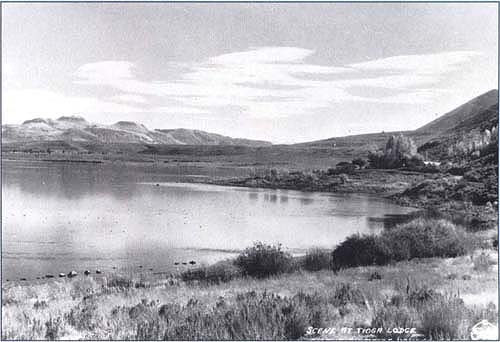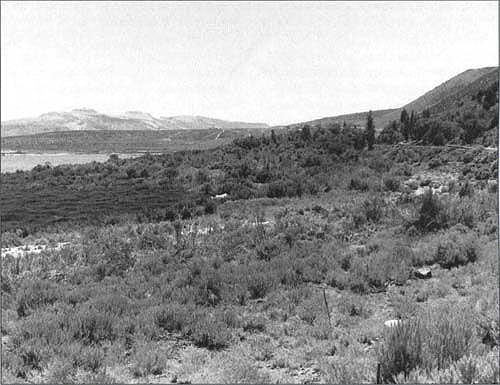All Issues
Sidebar: Mono Lake compromise: A model for conflict resolution
Publication Information
California Agriculture 49(6):15-16. https://doi.org/10.3733/ca.v049n06p15
Published November 01, 1995
PDF | Citation | Permissions
Abstract
Abstract Not Available – First paragraph follows: Mono Lake is a unique natural resource in California and the rest of the world. The lake evolved as a hydrologically closed basin, having no ocean outlet. Estimated to be 1 million years old, it is a remnant of the much larger ice-age Lake Russell. Lake Russell created a series of linked ecosystems: saline lake waters linked to hot and cold springs, fringing wetlands, riparian corridors and terrestrial uplands. Such a series of ecosystems is found nowhere else in the world. The unique ecology of this lake has been greatly threatened in this century by the development of California's water resources.
Full text
Mono Lake is a unique natural resource in California and the rest of the world. The lake evolved as a hydrologically closed basin, having no ocean outlet. Estimated to be 1 million years old, it is a remnant of the much larger ice-age Lake Russell. Lake Russell created a series of linked ecosystems: saline lake waters linked to hot and cold springs, fringing wetlands, riparian corridors and terrestrial uplands. Such a series of ecosystems is found nowhere else in the world. The unique ecology of this lake has been greatly threatened in this century by the development of California's water resources.
Early in the century, the City of Los Angeles bought up vast tracts of land with their riparian water rights — which allow use of the stream's water on adjoining land — in the Owens Valley and the Mono Basin, which lies north of the valley. This was to preclude claims to water by riparian owners. For its own diversions, the City obtained “appropriative” rights to remove water from the Owens and Mono Basins. Many of the latter rights were obtained from the State Water Resources Control Board by permits acquired in 1940 and licenses issued in 1974.
The stream flows of this region had been used for decades to support agricultural production in the Owens Valley and to sustain native species. In about 1913, however, prior to establishment of a state permit system that regulated appropriation of surface water for non-riparian purposes, the Los Angeles Department of Water and Power (LADWP) began exporting these waters for urban use via an aqueduct system to Southern California. (The state permit system went into effect in 1914.) The City and LADWP had begun a decades-long process of landscape change in eastern California.
Above, Mono Lake circa 1930. Below, Mono Lake in 1993. Beginning in 1941, water was diverted from Mono Basin for Los Angeles. Over the next 40 years the water level of the lake dropped approximately 45 feet.
While this project was certainly an engineering marvel and provided the City with high quality, inexpensive water, it also led to the demise of agriculture and components of the natural ecosystem in the Owens Valley.
Owens Lake desiccated as sections of the Owens River channel were left dry and tributary streams were dammed and diverted. Mono Lake too was altered through the capture and diversion of water by LADWP from its four major feeder streams (Lee Vining, Walker, Parker and Rush creeks), all of which issue from the crest of the Sierra Nevada. Beginning in 1941, as many as 90,000 acre-feet of water were diverted each year from Mono Basin for Los Angeles. Over the next four decades until 1981, the level of Mono Lake dropped from an elevation of 6,417 feet to 6,372 feet — a decrease of approximately 45 feet.
The impacts on the lake, shoreline and upland ecosystems were abrupt and also threatened to be long-lasting. With less freshwater inflow, the lake's already extremely high salinity rose from 51.2 grams per liter to 99.4 grams per liter. This increased salinity threatened the productivity of the brine shrimp population and associated phytoplankton. In addition, the drop in lake levels caused the loss of the hard-bottom habitat that is critical for the alkali fly. (It is necessary for one portion of their lifecycle where they are sedentary.) Mono Lake's brine shrimp and alkali flies are critical food resources for many migratory and breeding birds such as California gull and snowy plover. In addition, the many wetlands, riparian woodlands and upland habitats near the lake were also threatened by decreases in runoff and associated changes in groundwater flow as well as by alkaline dust blowing off the now-exposed toxic, alkaline playa (the exposed lakebed sediments containing high levels of arsenic, boron and other elements).
The environmental community recognized the deterioration in Mono Lake and the surrounding areas, but how could this legal diversion of water by Los Angeles be stopped? Of greatest relevance to Mono Lake was the use of the common-law public trust doctrine, which protects access to and enjoyment of navigable waterways and affiliated resources. Also relevant were specific provisions in the California Fish and Game code that mandated release of water from dams to maintain downstream fish populations in “good” condition. Although these tools were in existence in 1940 and earlier, social attitudes toward natural resources and the environment at that time made it highly unlikely they would have been used by the courts as they were in the 1980s. However, societal attitudes had changed dramatically by the 1970s, as evidenced by passage of the federal Clean Air Act and Clean Water Act, in 1970 and 1972 respectively, and the California Environmental Quality Act (CEQA) in 1971.
Prompted by 1976 student research findings showing severe impacts of water diversions on the Mono Basin ecosystem, students, scientists and other conservation-minded individuals undertook a massive, grassroots effort to “Save Mono Lake.” The Mono Lake Committee and Mono Lake Foundation were formed to educate the public and legislators about the issue and to reduce the diversion of tributary waters from the basin. Litigation ensued in the form of suits filed under the public trust doctrine (in 1979) and the California Fish and Game code (in 1985). In 1989, the relevant court issued a stay of its proceedings pending completion of work on the matter by the State Water Resources Control Board (SWRCB). Before it issued its decision, this board prepared an Environmental Impact Report pursuant to the CEQA. The SWRCB decision referred both to the antidegra-dation policy derived from the Clean Water Act and to air quality standards derived from the Clean Air Act.
After many years in court and the establishment of the region as the Mono Lake National Scenic Area under Congressional directive, the State Water Resources Control Board in September 1994 issued an order (Decision 1631) to reduce greatly LADWP's diversions of water from the Mono Basin and restore the lake to an elevation of 6,392 feet, a level last seen in 1964. This level was a compromise that would achieve several, but not all, ecosystem health objectives.
Interestingly, as the direction of the pending decision became clear, those who once opposed the process began to work together to discuss the future restoration of Mono Lake and its associated ecosystems and to find Los Angeles another source of water. An independent team of consulting scientists has begun to restore riparian vegetation and natural stream morphology of the rewatered tributaries. The California legislature and the federal Bureau of Reclamation made funds available to the city to undertake metropolitan water reclamation and to pursue water reuse and conservation. With the signing of AB 3096 by Governor Wilson, appropriation of $9 million per year over 4 years began as authorized by AB 444 in 1989. The federal government is providing additional finds through HR 429. These actions could produce more than 200,000 acre-feet of water per year, as noted by UC Davis law professor H.C. Dunning and others.
Mono Lake Committee Executive Director Martha Davis, speaking July 21, 1995, at the annual conference of the Sierra Nevada Alliance, aptly stated that with this victory in hand, the biggest challenge is now ahead of us: implementation of the State Regional Water Resources Control Board's order to restore Mono Lake. If our climate system behaves normally, we should be able to watch many of the elements of Mono Lake's ecosystems restored over the next 40 to 50 years — within our lifetimes. Observing this process will teach us a great deal about the restoration of other degraded ecosystems, which will benefit California as a whole.
The Board's order achieved a win-win situation for the economy and the environment, and initiated a learning process that will enable us to better manage, restore and conserve our natural resources in the future. In Mono Lake's story, we have seen how a grassroots political effort can achieve many of its goals, how our laws can be appropriately used for resource protection, and how agencies can work across administrative boundaries for the good of the resource. It is an excellent model for future management of California's linked urban-agricultural-natural ecosystems.






